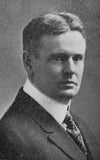
Frederic R. Hamilton took office as Marshall College’s third president on September 1, 1919, having been selected by the State Board of Control a few weeks’ previous. Hamilton shepherded the institution while it became a full four-year degree granting college. With the demand for more properly trained teachers, he worked toward that goal. The college’s first bachelors degrees were granted at the June 1921 Commencement. At Hamilton’s suggestion, faculty member Vera Andrew wrote and produced a pageant, The Unquenched Torch, two days before commencement in celebration of the occasion. Hamilton was a good administrator and the school expanded under his leadership. He was “very popular indeed with the entire student body—and no wonder, for he [took] an active interest in all worthy student activities.” He was not so popular with some of the faculty, who agitated that Morris P. Shawkey, the former State Superintendent of Education, should take his place as the College’s president. Apparently, Hamilton gave in to these pressures and resigned in 1923 to accepted a position as assistant professor of education at Columbia, where he could also complete his doctorate.
Frederic Rutherford Hamilton, the son of Andrew Hamilton and Jane (Hessen) Hamilton, was born on July 31, 1881, at Richland Center, Wisconsin. He graduated from the State Normal School at Oshkosh, Wisconsin, in 1901. Between 1901 and 1912 he was the superintendent of schools for the cities of Milton, Jefferson and Hudson, Wisconsin. During this time he also continued his schooling, earning a bachelors of philosophy from University of Wisconsin in 1906. On June 26, 1906, he married Marion Ethel Warren; the couple had two children. From 1912 to 1914 he worked for the extension division of the University of Wisconsin, and from 1914 to 1918 he was the director of the extension division of the University of Kansas. During the First World War, from 1918 to 1919, he worked with the United States Sanitary Corps, Hospital Service at Waynesville, South Carolina. At the time he accepted the position of president at Marshall University in 1919, he was working toward a Ph.D. by attending summer sessions at Columbia University. Upon leaving Marshall College in 1923, he returned to Columbia as an associate professor of education, where he earned his doctorate in 1925.
In 1925 he accepted the position as president of the Bradley Polytechnic Institute (now Bradley University) at Peoria, Illinois. He guided the institution through the difficult years of the Depression and World War II. Between 1942 and 1943 he also worked in the Division of Higher Education, U.S. Department of Education, where he assisted “in the preparation of war training courses for the nation’s colleges and universities.” He held the position of president at Bradley Polytechnic Institute until 1946, when he retired at the age of sixty-five.
He did not seek a life of leisure after his retirement. In 1946 he accepted the position as the new dean of the University of Illinois, Galesburg Division, where he stepped in at the last moment and got the school up in running in a matter of weeks. He remained there until 1947. He accepted a position on a number of expeditions between 1947 and 1952. He accompanied these exploratory-photographic expeditions around the world, including Canada, South America, Australia, New Zealand and Africa. On February 19, 1952, he died on the steamer, African Enterprise, while returning to New York City from an expedition to Africa. He was buried with his wife, who had died in 1942, at Brownswood Cemetery, Hinsdale, Illinois.
Principals
- Isaac N. Peck, 1837-1839
- Jacob H. Patton, 1839- 1840
- Alfred E. Thom, 1840-1843
- Josiah B. Poage, 1843-1850
- Henry Clark and Joseph Foster, 1850
- William B. McFarland, 1850-1853
- Staunton V. Field, 1853-1854
- William R. Boyers, 1854-1858
- Benjamin H. Thackston, 1858-1861
- Rev. J. M. Brown, 1861
- Daniel W. Thrush, 1861
- Salina C. Hite Mason, 1863-1867
Presidents
- Stewart Harold Smith, 1961-1968
- Roland Hill Nelson, Jr., 1968-1970
- Donald Newton Dedmon, 1970-1971
- John Grove Barker, 1971-1974
- Robert Bruce Hayes, 1974-1983
- Sam Edward Clagg, 1984
- Dale Frederick Nitzschke, 1984-1990
- Alan Brant Gould, 1990-1991
- James Wade Gilley, 1991-1999
- Audy Michael Perry, 1999-2000
- Daniel Duane Angel, 2000-2005
- Michael Joseph Ferrell, 2005
- Stephen James Kopp, 2005 – 2014
- Gary G. White, 2014 – Jan 2016
- Jerome A “Jerry” Gilbert, 2016 – present
Bibliography With Source Notes
Created by Lisle Brown, former Curator Special Collections
Exhibits By Category
CONTACT
- Special Collections, Morrow Library, Marshall University, One John Marshall Drive, Huntington, WV 25755
- speccoll@marshall.edu
- 304-696-2343 telephone
- 304-696-2361 fax (800) 818-9816 toll free
OTHER RESOURCES
- Staff/Faculty
- Directions
- Research & Duplication Fees
- Regular Hours: Mon – Fri: 8 am – 4:30 pm; Sat – Sun: closed
- Contribute to Lisle Brown Memorial Fund